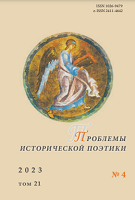Агионимы в русских свадебных приговорах
Holy Names in Russian Wedding Speeches
Author(s): Yulia KrasheninnikovaSubject(s): Christian Theology and Religion, Cultural history, Recent History (1900 till today), Sociology of Culture, 19th Century, Biblical studies, Sociology of Religion
Published by: Петрозаводский государственный университет
Keywords: Russian wedding rite; wedding speeches; Holy Names; agionyms; aghioanthroponyms;
Summary/Abstract: The paper considers the Holy Names (agionyms) that occur in the texts of wedding speeches. The reasons and mechanisms of inclusion of these nominations in the text of wedding rites are analyzed, the key and frequent onyms related to sanctity are highlighted. The work uses a wide range of sources — archival and published materials of the 19th - early 21st centuries. Аghioanthroponyms, aghiotoponyms, eortonyms, templeonyms, and icononyms are recorded in wedding speeches. The group of agioanthroponyms consisting of the names of characters of the Christian pantheon, the Old and New Testaments, famous Christian saints is multifarious. The frequent agioanthroponyms are Jesus Christ, the Mother of God, and Nicholas the Wonderworker, the use of which in some texts in pairs (Spas - Nicholas / Spas - the Mother of God / Nicholas - the Mother of God) indicates that they are endowed with an equal degree of holiness in popular beliefs. The names of biblical characters Adam and Eve are next in frequency of use: their mentioning in the wedding text is connected with the perception of these characters as the progenitors of the human race. The rest of the agioanthroponyms are fixed in single variant, their appearance in the text is sporadic and irregular. Each name has certain meanings in the biblical cultural tradition, and the situation associated with it refers to a certain biblical story. The knowledge of these stories and their articulation by both sides of the wedding rite makes it possible to clarify the cultural orientations and value attitudes of those who came for the bride, as well as the similarity of these attitudes to the perceptions of the bride’s family. Other varieties of agionyms (agiotoponyms, eortonyms, templeonyms) are represented in speeches by one or two examples; their appearance in folklore texts is not a systematic occurrence.
Journal: Проблемы исторической поэтики
- Issue Year: 21/2023
- Issue No: 4
- Page Range: 44-62
- Page Count: 19
- Language: Russian

